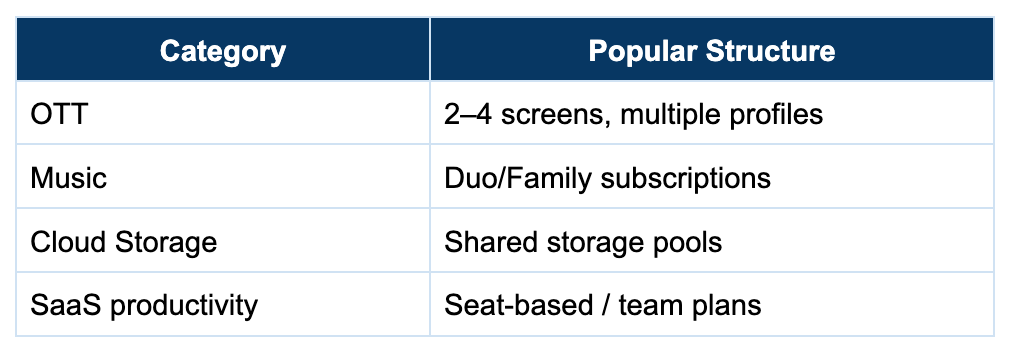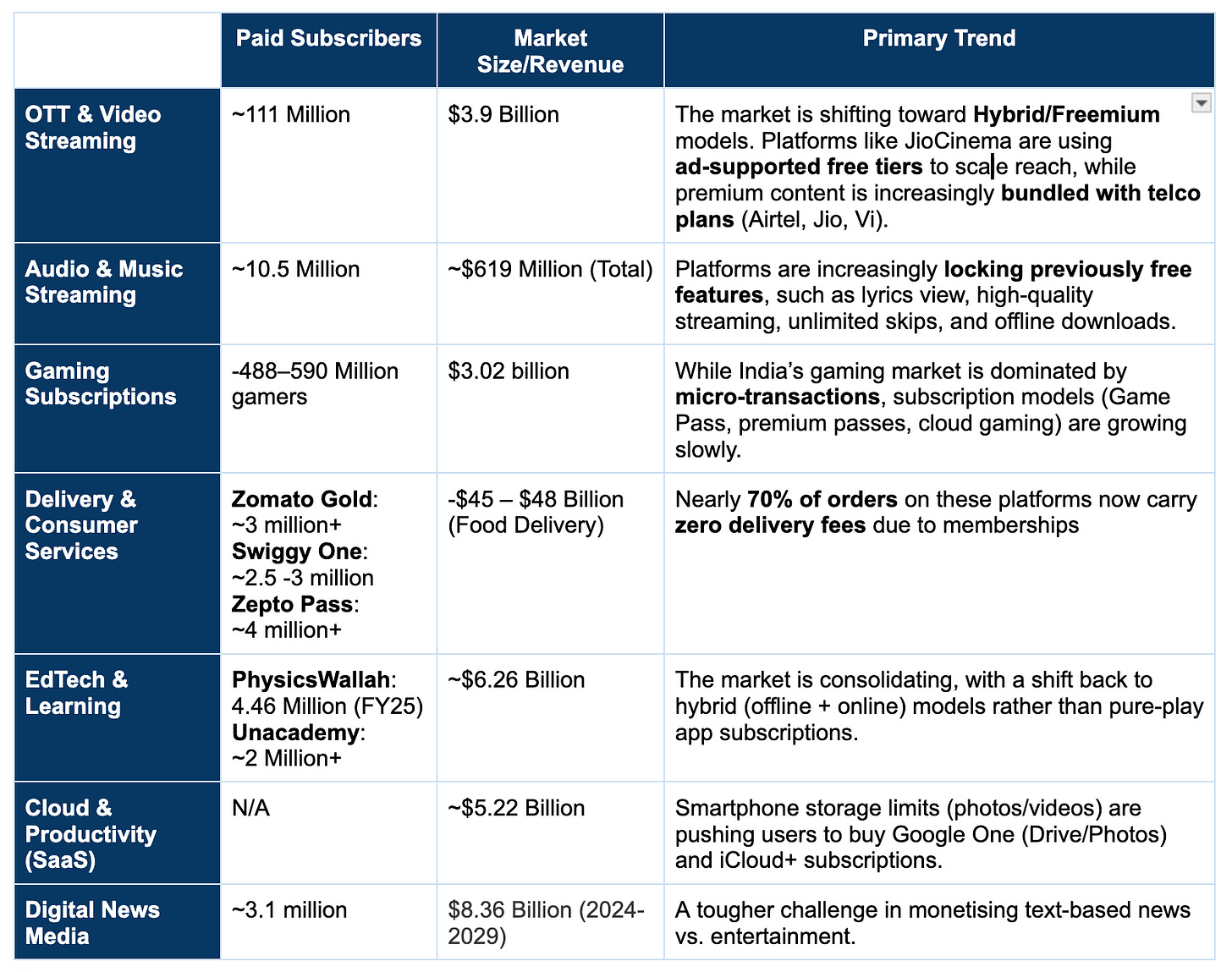The Psychology of Subscriptions in India: What Works in Tech & Why?
In this article, we break down the psychology behind what actually works in India’s tech subscription landscape and why certain models outperform others.
India’s subscription economy is growing, but not in the way Western models predicted. Indian consumers don’t subscribe because a product is convenient or trendy. They subscribe when it feels valuable, rewarding, safe, and, most importantly, in their control.
And this is exactly why tech products have cracked the subscription code better than most categories. Apps like Spotify, YouTube Premium, Amazon Prime, Hotstar, Cure.fit, and others succeed because they tap into Indian psychological triggers: reducing daily friction, delivering visible savings, offering status, building habits, and providing instant gratification.
In this article, we’ll break down the psychology behind why subscriptions thrive in tech products- what Indian users emotionally respond to, the micro-behaviours that drive retention, and the design patterns that turn a simple app into a daily ritual.
Why are Subscription Models Still a Challenge in India?
To understand what works, we need to understand the environment we’re designing for. India’s subscription dynamics differ due to:
1. Regulatory & payment infrastructure constraints
The RBI’s recurring payment guidelines introduced friction in auto-debit flows, particularly for monthly card payments below ₹5,000. Many recurring payments started failing after 2021, forcing brands to shift toward:
UPI Autopay & e-Mandates
Longer billing cycles (quarterly/annual instead of monthly)
Higher transparency and reminder flows before renewals
2. Strong price sensitivity & value justification
Even premium Indian consumers scrutinise monthly charges. A one-time ₹499 purchase feels easier than a ₹99/month subscription because the latter is an ongoing mental and financial commitment.
3. Cultural preference for flexibility
India has a deep-rooted pay-as-you-go culture:
Prepaid mobile
Paying domestic staff daily/weekly
Ordering groceries and meals on demand
Subscriptions often feel like giving up control.
4. Trust deficit with recurring billing
Many people worry that brands will “keep deducting money even if I’m not using it.”
This means cancellation, pausing, and skipping options need to be ultra-transparent.
5. Subscription fatigue is real.
Between OTT platforms, grocery memberships, cloud storage, learning apps, and fintech upgrades, people are simply tired of paying for too many recurring services.
The bar for perceived value is now much, much higher. Despite these barriers, some categories thrive- if executed thoughtfully.
In India, subscription models succeed when they revolve around three things:
Clear savings (real rupees saved, displayed prominently)
High usage frequency (something you use weekly or daily)
Convenience or habit reinforcement (the service makes life easier)
So, what actually works? To answer that, you need to look at subscriptions through two different lenses.
Tech Subscriptions in India
India’s tech subscription ecosystem has transformed dramatically in the last five years. What began with OTT streaming and cloud storage has now expanded into food delivery memberships, gaming passes, productivity tools, personal finance, and digital news.
Across OTT, music, news, gaming, delivery, cloud, and SaaS, one pattern is clear: Indians are willing to pay for digital services when three conditions are met- continuous value, high-frequency usage, and visible savings or outcomes.
How Tech Subscriptions Are Structured in India?
Tech subscriptions in India are not built on the typical Western model of monthly auto-renewals and feature paywalls. Instead, they rely on a structure shaped by value sensitivity, telecom partnerships, UPI-based billing, and a culture of shared digital consumption.
1. Bundling & Ecosystem Packaging
OTT, music, and cloud subscriptions are frequently bundled with Jio, Airtel, and Vi prepaid, postpaid, and broadband plans- reducing perceived cost and driving mass adoption.
This approach has extended into:
Credit cards with subscription perks
Broadband plans offering OTT bundles
Smart TV and device partnerships with preloaded premium trials
2. Hybrid / Freemium Access Models
Platforms like JioCinema, Spotify, and YouTube Music convert users by offering free ad-supported tiers and nudging upgrades for better quality, ad-free access, or premium content.
3. Flexible Billing Cycles
Due to UPI mandate failures and trust issues, India leans toward quarterly and annual plans with stronger savings, family plans, and lower cancellation frequency.
4. Usage-Based & Transaction-Linked Benefits
Memberships like Swiggy One & Zomato Gold show real rupee savings (free delivery, reduced platform fees), making renewals feel financially justified.
5. Outcome-Based & Progress-Linked Structures
EdTech and upskilling subscriptions retain users by tying value to improvement- certifications, dashboards, habit streaks, and mentor access.
6. Multi-Device, Multi-Profile Access
To fit the cost-sharing behaviour in Indian households:
7. UPI Autopay + reminder-driven renewals
RBI mandates make UPI-based subscriptions and pre-renewal reminders standard to reduce involuntary churn and anxiety around auto-debits.
Sectors Where Tech Subscriptions Work
Below is a sector-wise breakdown of how the market is evolving & how well subscription is performing (2024 estimates).
Source: India Online Food Delivery Market Attained Value of USD 48.07 Billion in 2024; FICCI-EY report on innovation and critical technologies; https://www.imarcgroup.com/india-mobile-gaming-market/requestsample; India Education Technology Market Size & Outlook, 2030
Pricing & ARPU Lessons from Successful Tech Subscriptions in India
Pricing is often the make-or-break factor for subscriptions in India. Unlike in Western markets, where digital spending is more habitual, recurring payments here compete directly with household essentials, mobile recharges, EMIs, school fees, and family entertainment budgets.
This is why the most successful tech subscriptions in India don’t rely on feature lists or paywalls alone. They anchor pricing around visible value, savings, bundling, and shared usage, turning subscriptions into smart financial decisions rather than discretionary digital expenses. And the strategies used by Netflix, JioCinema, Swiggy One, and Zomato Gold reveal exactly how to price for India’s value-conscious subscription economy.
1. Netflix: Premium ARPU through Positioned Value
How do they price for India:
Mobile-only plan brought down the entry barrier
Multi-screen and Ultra HD kept high-value tiers intact
Content strategy focuses on high-quality originals + global catalogue
2. JioCinema: Freemium + Ad Model
Unlike Netflix, JioCinema focuses on scale-first monetisation:
Free access fuels mass user acquisition
Premium sports and 4K viewing locked behind paid tiers
Bundles offered via Jio mobile & broadband plans
3. Swiggy One & Zomato Gold: Transaction-Linked Savings
These food delivery memberships use a hard-savings model:
Free delivery
Reduced platform and surge fees
Exclusive offers on Instamart/Blinkit, dining-out partners, and popular restaurants
Priority support or faster delivery windows in some cities
This is ROI-backed pricing- the strongest pricing psychology in India. In fact, industry data indicates that Gold/One members order 35-40% more often than non-members, and a large share of orders on these platforms now carry zero delivery fees, driven by these subscription programs.
How to Know If Your Tech Product Is Ready for Subscriptions?
Most tech founders want to launch subscriptions early, but timing is everything. A subscription model only works when your product has earned its place in the user’s daily or weekly life. Here’s how to know if your tech product is truly ready:
1. Your Product Has a Strong Habit Loop
Subscriptions thrive when users return repeatedly without being prompted. If your product naturally drives daily or weekly usage like fitness apps, OTT, productivity tools, music, or fintech utilities- you’re ready.
If you still depend heavily on push notifications to bring users back, it’s too early.
2. A “Pain Point” Gets Removed Because of Your Product
Tech subscriptions work when they eliminate everyday friction:
Ads disappear
Cleaner UI
Unlimited access
Faster support
More storage
Premium features that save time
3. There’s Clear, Upgradable Value
Users should immediately understand what they unlock by paying. If your value is vague (“more features”), it won’t convert.
If it’s specific (“download offline,” “unlimited swipes,” “priority support,” “access to advanced tools”), subscriptions click.
4. You Have at Least One Cohort With High Retention
Subscriptions are not built on virality; they’re built on retention. Before launching, ask: Is there a single user group that consistently returns month after month?
5. Your Product Delivers Measurable Outcomes
Tech subscriptions work best when users see results:
Steps walked
Habits completed
Productivity improved
Languages learned
Skills upgraded
Finances tracked
Outcome-driven products form long-term engagements, and that’s the backbone of recurring revenue.
How to Start a Tech Subscription Model in India?
1. If you’re a consumer tech app (food, grocery, mobility, fintech)
Offer lower fees, free deliveries, and priority support.
Provide special offers/boosters (e.g., credit card cashback, NEFT fee waivers, extra points).
Use milestone-based unlocks.
Keep renewal flows inside the app home, not hidden in Settings.
Strong winback offers when users cancel: offer pause, downgrade, or a 1-month trial at a lower price.
2. If you’re a SaaS / B2B tech product
Offer regional language support, GST invoices, and UPI/NEFT payment.
Add-on subscriptions for: Extra users, premium support, and advanced analytics.
Provide bundle training, onboarding, and quarterly reviews as part of higher plans.
Final Thoughts
If your tech product genuinely makes life easier, saves time, removes frustration, or becomes part of a daily routine, people happily pay. But the moment a subscription feels confusing, pushy, or not worth the money, Indian users hit “cancel” faster than the app can send a renewal reminder.
Build a subscription that respects the user’s intelligence, their wallet, and their need for transparency. And above all, make sure the product actually solves something important in their lives because in India, only the apps that earn a spot in the daily routine earn a spot in the monthly budget.
In the next part, we dive into D2C subscriptions- how brands use recurring orders, “subscribe & save,” and retention tactics to build predictable revenue. If you’re curious or if you know someone who runs a D2C brand, feel free to read the next part and share it with them.
At Razorpay Rize, we get it- building a startup is tough. That’s why we’re more than just a space for connecting with other founders. We’ve got programs, tools, and services designed to take some of the weight off the shoulders and make the journey just a little bit easier.
Curious about how we support startup founders?







